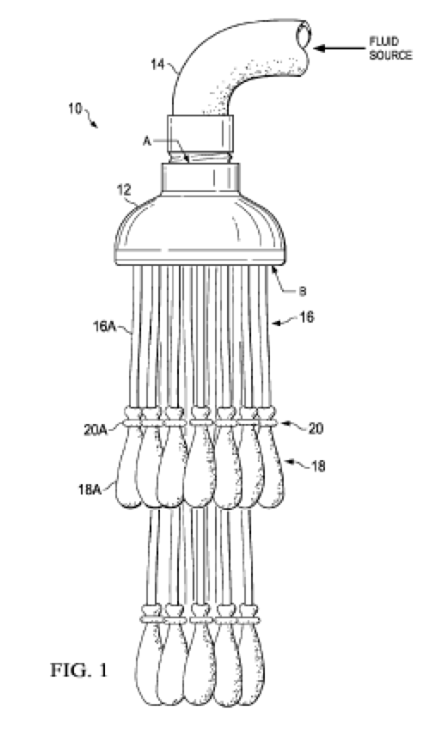In PGR2015-00018, Petitioner Telebrands Corp. filed a petition for post-grant review of claims 1-14 of U.S. Patent No. 9,051,066 (filed September 2014, issued June 2015). In the attached decision, described below, the Board instituted post-grant review, finding that the Petitioner had established a reasonable likelihood of prevailing on its challenges to the claims under 35 U.S.C. §§ 112 and 103.
The ‘066 patent is titled “System and Method for Filling Containers with Fluids,” and describes an apparatus for filling multiple water balloons simultaneously:
Hollow tubes 16 fill the balloons 18 with water, and when the balloons 18 are “substantially filled” with water, a user can shake the tubes 16 to detach sealed balloons. If you’re interested in learning more about this technology, see the following Youtube video, which shows a similar apparatus:
Interestingly, Petitioner actually cited this Youtube video as an exhibit and applied it in a Section 103 rejection in the Petition. Unfortunately for the Petitioner, the Board determined that the video did not predate the effective filing date of the ‘066 patent and so was not prior art.
PGR may be requested based on any ground related to patent invalidity under 35 U.S.C. § 282, which includes challenges under 35 U.S.C. § 112. The Petitioner took advantage of this and challenged the claims under 35 U.S.C. §§ 112(a) (non-enablement) and 112(b) (indefiniteness). Among other arguments, Petitioner asserted that the claim term “substantially filled” was indefinite. (Decision at 9-14.)
In considering this argument, the Board noted explicitly that “[t]he standard for indefiniteness that we have applied . . . is whether the claim language is ‘cast in clear—as opposed to ambiguous, vague, indefinite—terms,’” citing the Federal Circuit’s In re Packard, 751 F.3d 1307 (Fed. Cir. 2014) decision. Interestingly, the Board’s decision did not cite the Supreme Court’s 2014 Nautilus v. Biosig opinion on indefiniteness. 572 U.S. __ (2014). While Nautilus’s “reasonable certainty” test undoubtedly governs indefiniteness challenges in district courts, the indefiniteness standard to be applied in PGR proceedings is not as clear. The Packard decision involved the indefiniteness standard used during examination at the USPTO and distinguished between the standard used in “pre-issuance” and “post-issuance” disputes. The concurring decision in Packard notes, for example, that the USPTO may apply a “lower threshold for ambiguity” than a district court. 751 F.3d at 1323. But indefiniteness in PGR proceedings does not squarely fit into either of the pre-issuance and post-issuance scenarios (e.g., in PGR, the presumption of validity no longer applies, but PGR does not offer an unfettered opportunity to amend, as in examination and reexamination). Although the Board did not apply Nautilus’s “reasonable certainty” standard here, it has done so in other proceedings. See SAP Am., Inc. v. Lakshmi Arunachalam, CBM2013-00013, Final Written Decision, Paper 61 at 11, 18-19 (P.T.A.B. Sept. 18, 2014).
Applying the standard for indefiniteness noted above, the Board found several of the claims to be unpatentable under 35 U.S.C. § 112(b). The Board stated that the specification of the ‘066 patent did not provide any objective standard for determining when a balloon was “substantially filled.” The Board further noted that the specification teaches that a balloon may be considered filled “when an individual subjectively determines that a ‘desired size’” has been reached. (Decision at 12-14.)
The Board next turned to Petitioner’s proposed grounds under Section 103. Patent Owner argued that Petitioner’s art did not teach the claimed “shake-to-detach” feature. The Board noted that the “shake-to-detach” feature used functional terminology and stated: “[T]he challenged claims are apparatus claims, which must be distinguished from the prior art in terms of structure rather than function. A claim employing functional terminology, such as claim 1 of the ’066 Patent, covers any embodiment that meets the structural limitations of the claim and that is capable of performing the recited function.” (Decision at 25.) Finding that the shake-to-detach feature is an inherent characteristic of the structure taught by the combination of references, the Board rejected the Patent Owner’s argument and held that the claims were unpatentable under Section 103. (Decision at 25-26.)
By: Joshua R. Nightingale (Jones Day Bio)
Jones Day's PTAB Team
Latest posts by Jones Day's PTAB Team (see all)
- Informative: How To Sufficiently Show that a Thesis is Publicly Accessible - April 13, 2020
- PTAB Designates Western Digital as Informative of Motions to Amend - June 1, 2018
- Proposed Rule: No More BRI in PTAB Trials - May 8, 2018

